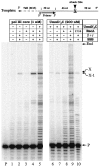Biochemical basis of SOS-induced mutagenesis in Escherichia coli: reconstitution of in vitro lesion bypass dependent on the UmuD'2C mutagenic complex and RecA protein
- PMID: 9707548
- PMCID: PMC21409
- DOI: 10.1073/pnas.95.17.9755
Biochemical basis of SOS-induced mutagenesis in Escherichia coli: reconstitution of in vitro lesion bypass dependent on the UmuD'2C mutagenic complex and RecA protein
Abstract
Damage-induced SOS mutagenesis requiring the UmuD'C proteins occurs as part of the cells' global response to DNA damage. In vitro studies on the biochemical basis of SOS mutagenesis have been hampered by difficulties in obtaining biologically active UmuC protein, which, when overproduced, is insoluble in aqueous solution. We have circumvented this problem by purifying the UmuD'2C complex in soluble form and have used it to reconstitute an SOS lesion bypass system in vitro. Stimulated bypass of a site-directed model abasic lesion occurs in the presence of UmuD'2C, activated RecA protein (RecA*), beta-sliding clamp, gamma-clamp loading complex, single-stranded binding protein (SSB), and either DNA polymerases III or II. Synthesis in the presence of UmuD'2C is nonprocessive on damaged and undamaged DNA. No lesion bypass is observed when wild-type RecA is replaced with RecA1730, a mutant that is specifically defective for Umu-dependent mutagenesis. Perhaps the most noteworthy property of UmuD'2C resides in its ability to stimulate both nucleotide misincorporation and mismatch extension at aberrant and normal template sites. These observations provide a biochemical basis for the role of the Umu complex in SOS-targeted and SOS-untargeted mutagenesis.
Figures



Similar articles
-
A model for SOS-lesion-targeted mutations in Escherichia coli.Nature. 2001 Jan 18;409(6818):366-70. doi: 10.1038/35053116. Nature. 2001. PMID: 11201748
-
Roles of E. coli DNA polymerases IV and V in lesion-targeted and untargeted SOS mutagenesis.Nature. 2000 Apr 27;404(6781):1014-8. doi: 10.1038/35010020. Nature. 2000. PMID: 10801133
-
The appearance of the UmuD'C protein complex in Escherichia coli switches repair from homologous recombination to SOS mutagenesis.Mol Microbiol. 1993 Dec;10(5):963-71. doi: 10.1111/j.1365-2958.1993.tb00968.x. Mol Microbiol. 1993. PMID: 7934872
-
Mutations for Worse or Better: Low-Fidelity DNA Synthesis by SOS DNA Polymerase V Is a Tightly Regulated Double-Edged Sword.Biochemistry. 2016 Apr 26;55(16):2309-18. doi: 10.1021/acs.biochem.6b00117. Epub 2016 Apr 12. Biochemistry. 2016. PMID: 27043933 Free PMC article. Review.
-
The biochemical basis and in vivo regulation of SOS-induced mutagenesis promoted by Escherichia coli DNA polymerase V (UmuD'2C).Cold Spring Harb Symp Quant Biol. 2000;65:31-40. doi: 10.1101/sqb.2000.65.31. Cold Spring Harb Symp Quant Biol. 2000. PMID: 12760018 Review. No abstract available.
Cited by
-
Escherichia coli nucleoside diphosphate kinase mutants depend on translesion DNA synthesis to prevent mutagenesis.J Bacteriol. 2011 Sep;193(17):4531-3. doi: 10.1128/JB.05393-11. Epub 2011 Jul 1. J Bacteriol. 2011. PMID: 21725024 Free PMC article.
-
A dnaN plasmid shuffle strain for rapid in vivo analysis of mutant Escherichia coli β clamps provides insight into the role of clamp in umuDC-mediated cold sensitivity.PLoS One. 2014 Jun 4;9(6):e98791. doi: 10.1371/journal.pone.0098791. eCollection 2014. PLoS One. 2014. PMID: 24896652 Free PMC article.
-
DNA polymerase V activity is autoregulated by a novel intrinsic DNA-dependent ATPase.Elife. 2014 Apr 24;3:e02384. doi: 10.7554/eLife.02384. Elife. 2014. PMID: 24843026 Free PMC article.
-
Regulation of the rulAB mutagenic DNA repair operon of Pseudomonas syringae by UV-B (290 to 320 nanometers) radiation and analysis of rulAB-mediated mutability in vitro and in planta.J Bacteriol. 2000 Nov;182(21):6137-44. doi: 10.1128/JB.182.21.6137-6144.2000. J Bacteriol. 2000. PMID: 11029435 Free PMC article.
-
The human DINB1 gene encodes the DNA polymerase Poltheta.Proc Natl Acad Sci U S A. 2000 Apr 11;97(8):3838-43. doi: 10.1073/pnas.97.8.3838. Proc Natl Acad Sci U S A. 2000. PMID: 10760255 Free PMC article.
References
-
- Friedberg E C, Walker G C, Siede W. DNA Repair and Mutagenesis. Washington, DC: Am. Soc. Microbiol.; 1995.
-
- Echols H, Goodman M F. Annu Rev Biochem. 1991;60:477–511. - PubMed
Publication types
MeSH terms
Substances
Grants and funding
LinkOut - more resources
Full Text Sources
Other Literature Sources
Molecular Biology Databases

